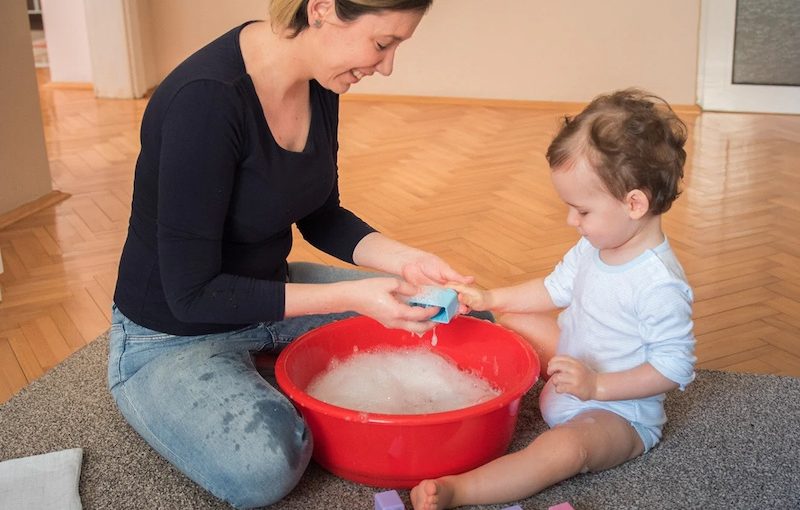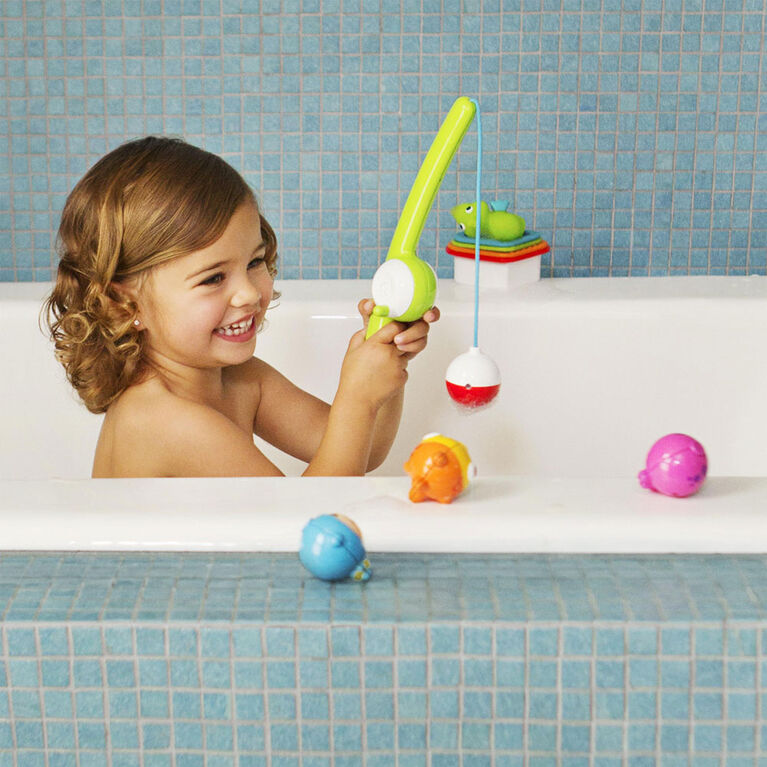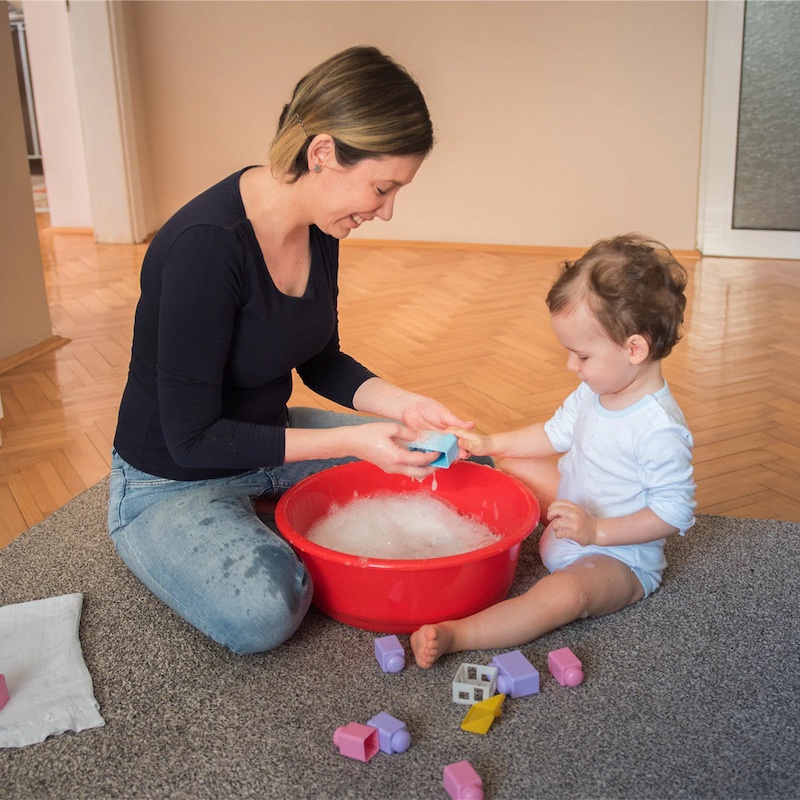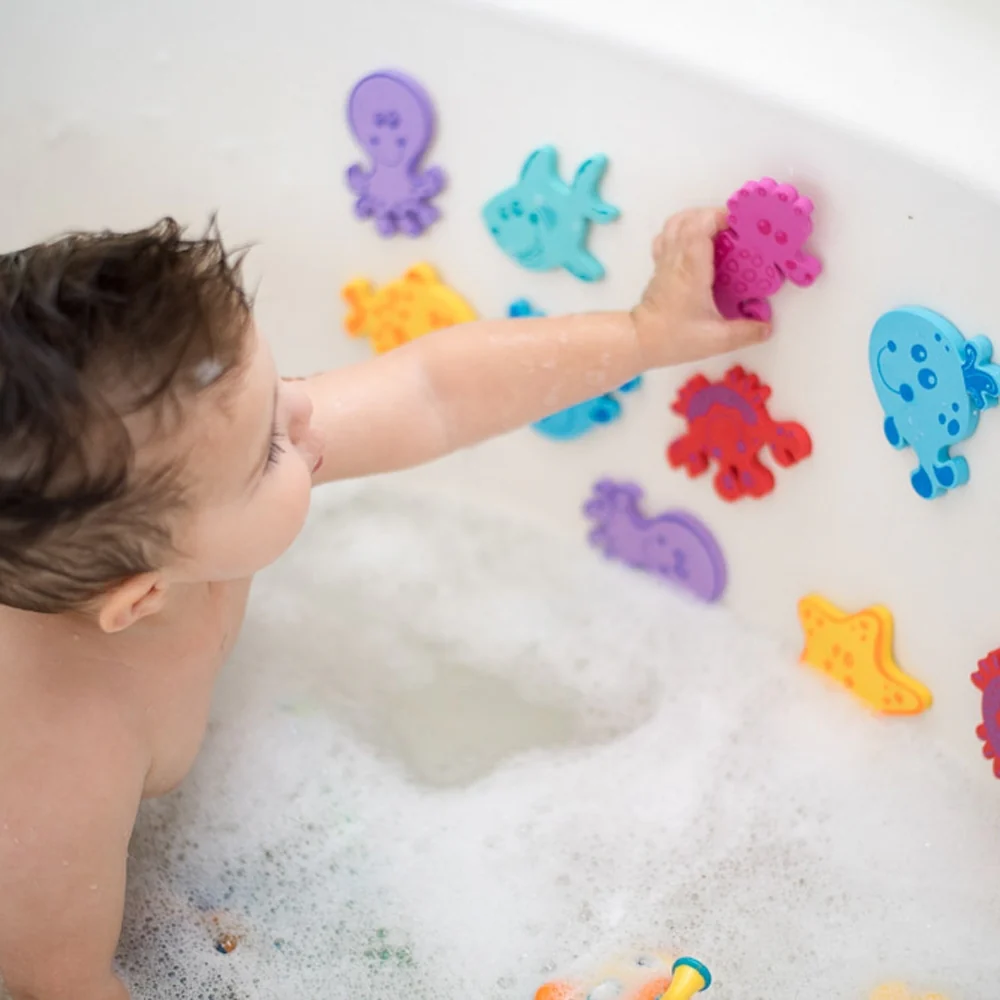Why Cleaning Bath Toys Is Important
Keeping kids’ bath toys clean is crucial for their health and safety. These toys often stay in moist environments. This can promote the growth of mold and bacteria. If kids chew on dirty toys, they may ingest harmful pathogens. This could lead to allergies, infections, and other health issues.
Clean toys also ensure a more hygienic bathroom. Mold spores from these toys can spread to other areas. This can contaminate surfaces and can even affect air quality. Cleaning these toys is not just about the child’s health. It’s about maintaining a clean home environment.
Lastly, clean bath toys last longer. Regular cleaning prevents material breakdown. This saves you money and reduces waste. We will explore key methods for how to clean kids bath toys. We aim to keep bath time both fun and safe for your children.
Signs of Mold and Bacteria on Bath Toys
It’s critical to recognize early signs of mold and bacteria on bath toys to ensure kids’ safety. Here are the common indicators:
- Discoloration: Check for unusual spots or changes in color, which often signal mold growth.
- Bad Odor: A musty or unpleasant smell emanating from toys can indicate the presence of bacteria.
- Slimy Texture: If the toys feel slippery or slimy, there’s a high chance that biofilm has formed.
- Visible Mold: Look out for black, green, or pink patches; these are clear signs of mold infestation.
Identifying these symptoms promptly helps in applying the right cleaning methods. Plus, it can protect children from potential health risks associated with mold and bacteria exposure. Now that we know what to look for, let’s discuss daily maintenance tips to keep bath toys in top condition.
Daily Maintenance Tips for Bath Toys
To minimize mold and ensure cleanliness, incorporate daily maintenance for your kids’ bath toys. Here are some essential tips you can easily follow:
- Dry Toys Thoroughly: After each bath, squeeze out all the water from toys and let them air dry. This prevents mold from taking hold.
- Keep Them Ventilated: Store the toys in a well-ventilated area to speed up drying and to keep moisture levels low.
- Regular Rotation: Don’t use the same toys every day. Rotate them to give each toy time to dry properly between uses.
- Use Mesh Bags: Hang bath toys in a mesh bag. It allows air flow and keeps toys organized while drying.
- Clean Water Play: Make sure the bath water is clean before playtime. Dirty or soapy water can encourage mold growth.
By carrying out these simple steps, you create a routine that helps how to clean kids bath toys while also preventing mold before it starts. Making daily maintenance a habit ensures a safer and more enjoyable bath time for children.
Step-by-Step Guide to Cleaning Bath Toys
Knowing how to clean kids bath toys is key to keeping them safe and mold-free. Follow this simple step-by-step guide to ensure your child’s toys are clean and sanitised:
- Gather Supplies: Start by getting what you need. This includes warm water, mild soap, vinegar or bleach, and clean cloths or a scrub brush.
- Prepare Cleaning Solution: Mix warm water with a splash of mild soap or a half cup of vinegar. For deeper cleans, use a mild bleach solution (one tablespoon of bleach per gallon of water).
- Soak the Toys: Submerge the toys in the cleaning solution. Let them soak for about 15 minutes to loosen dirt and kill germs.
- Scrub Thoroughly: After soaking, take a brush or cloth and scrub the toys well. Pay special attention to crevices where mold might hide.
- Rinse Well: Rinse the toys under warm running water. Be sure to remove all cleaning solution residues to prevent your kids from exposure to cleaners.
- Squeeze Out Water: For toys that can retain water, squeeze them out completely. This step is vital to prevent mold from growing inside the toys.
- Dry Completely: Air dry the toys or use a clean cloth. Ensure they are entirely dry before storing or using them again.
- Inspect Regularly: Always check toys before bath time for any signs of mold or a musty smell. If you find any, repeat the cleaning process.
By taking these steps, you create a cleaner, healthier play environment for your kids. Plus, you extend the life of their favorite bath toys. Remember, consistency is key. Make cleaning a regular part of bath toy care for the best results.
Natural Cleaning Solutions for Bath Toys
When you’re considering how to clean kids bath toys, natural solutions are a safe and effective option. Here are some eco-friendly ways to keep those toys spotless without harsh chemicals:
- Vinegar Bath: Mix equal parts of white vinegar and water. Soak the toys in this solution for an hour, then rinse well. Vinegar’s acidity helps kill mold and bacteria.
- Baking Soda Scrub: Make a paste with baking soda and water. Apply it to the toys, scrub, and then rinse. It’s great for removing grime and neutralizing odors.
- Tea Tree Oil Rinse: Add a teaspoon of tea tree oil to warm water. After cleaning, rinse toys in this mixture. Tea Tree oil has natural antifungal and antibacterial properties.
- Lemon Juice Spritz: Spritz toys with lemon juice. The citric acid can break down mold. Afterward, place toys in the sun to dry, as UV rays also help disinfect.
- Sunlight: Simply leaving the toys to dry in direct sunlight can help disinfect them due to the UV rays, and it’s completely natural.
By using these natural options, you’re avoiding additives that could be harmful to your child. Additionally, these methods are not only safe for the toys but also for the environment. Incorporating these natural cleaning solutions into your maintenance routine can contribute to a healthier bath time experience.
Preventing Mold: Best Practices
Preventing mold in kids’ bath toys is not a one-time action, but a series of best practices to follow regularly. These steps can help ensure that your children can play with their toys without health risks and that the toys themselves remain in good condition for longer.
- Keep Toys Dry: Moisture is mold’s best friend. Always dry toys after use. A dry towel can speed up the process.
- Close Holes: Seal any holes in toys to keep water out. This can prevent mold from growing inside.
- Control Bathroom Humidity: Use a dehumidifier or fan to reduce moisture in the bathroom. This makes it less inviting for mold.
- Choose Mold-Resistant Toys: Opt for toys made of solid materials or ones that are labeled ‘mold-resistant’. These are easier to keep mold-free.
- Avoid Organic Materials: Organic materials, like sponges or fabrics, hold moisture. Instead, select toys made from plastic or rubber.
- Boil Toys Regularly: Boil bath toys occasionally to kill mold spores and bacteria. Always check toy labels for temperature safety first.
- Educate Kids: Teach children not to drink bath water. It can spread mold and bacteria.
- Inspect Toys Often: Look over toys frequently for signs of mold. Prompt action can stop mold in its tracks.
By combining these practices with how to clean kids bath toys, you create a comprehensive shield against mold. Following these guidelines promotes a cleaner, safer environment for your child’s bath time adventures.
Choosing the Right Bath Toys to Reduce Mold Risk
Selecting the right toys can make how to clean kids bath toys easier and more effective. Here’s how you can choose toys with less risk of mold:
- Opt for Simplicity: Simple shapes with fewer crevices prevent mold. They are easier to clean.
- Solid Toys: Choose toys without holes. Water can’t get inside, reducing mold growth.
- Quality Materials: Buy toys made from durable, non-porous materials. They resist mold better.
- Mold-Resistant Labels: Seek out toys specifically labeled as ‘mold-resistant’. They’re designed to prevent mold.
- Avoid Foam Toys: Foam soaks up water and can harbor mold. Stick to plastic or rubber.
By considering these factors when purchasing bath toys, you can minimize the risk of mold and maintain a healthier play area. A wise choice in toys, paired with your cleaning and maintenance routine, can go a long way in keeping your child’s bath time safe and enjoyable.
Frequently Asked Questions About Bath Toy Hygiene
Parents often have questions about keeping their children’s bath toys clean and safe. Here we address some common FAQs on bath toy hygiene:
- How often should I clean bath toys?Clean bath toys weekly to prevent mold. After use, always rinse and dry them thoroughly.
- Can I just use water to clean the toys?Water alone can’t kill germs. Use mild soap or a natural disinfectant like vinegar for effective cleaning.
- What should I do if I see mold inside a toy?Toss the toy if mold is inside, as it’s hard to remove. Next time, choose solid toys without holes.
- Is it safe to use bleach on bath toys?Yes, but use a weak bleach solution and rinse toys well. Bleach kills mold but needs careful handling.
- Can dishwasher-safe toys go in the dishwasher?Yes, if labeled dishwasher-safe. The heat can sanitize toys. Just check the toy’s cleaning instructions first.
- Should I dry toys with a towel or air dry them?Air drying is best. But, a clean towel can help if needed, especially for quick drying inside crevices.
- What are mold-resistant toys?Mold-resistant toys are made from materials less likely to grow mold. Look for this label when you buy.
- Can I use essential oils to clean toys?Yes, tea tree oil is a natural option. It has antibacterial properties. Always dilute it in water before use.
By understanding how to clean kids bath toys and addressing these FAQs, you maintain a mold-free, healthy play area. Remember, regular cleaning and proper toy selection are key to a happy and healthy bath time.



